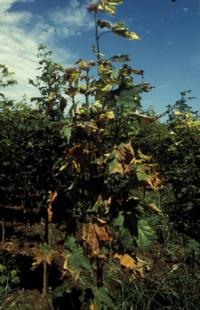Unused stories
Pest of the Month - Verticillium wilt
Are your tomatoes wilting?

Verticillium wilt is a fungal disease that infects a plant’s vascular system causing wilting of leaves, hence the name. The two main damage-causing species of this soil-borne pathogen are Verticillium albo-atrum and V. dahlia. The fungus persists in the soil for many years and invades the root system directly or through wounds caused naturally by root growth through the soil or soil organisms. With its ability to spread systemically within the plant and kill it, it is considered a serious disease.
It affects hundreds of herbaceous and woody plant species – common tree hosts include ash, camphor, Chinese pistache, maple and pepper, apricot and olive. In bush fruits like raspberry and blackberry it’s known as blue stem. The understock of grafted roses is very susceptible, as are many ornamentals – barberry, begonias, dahlias, geraniums, poppy, snapdragons and viburnum. In addition to tomatoes, other food crops – barley, wheat and oats, potato and eggplant, cabbage and globe artichokes, may be infected.
By preventing the plant from moving water from the roots to the leaves, newer foliage wilts and the color in older leaves fades, ultimately turning yellow or brown. Symptoms of the disease can occur anytime during the growing season, often in spring and fall, but are apt to appear when the weather is hot and the plant is stressed. Symptoms may be acute - leaf curling, drying, an abnormal red or yellow color of leaves or areas between leaf veins, partial defoliation, wilting and branch dieback, often with one branch or side of the plant infected, or chronic - yellow foliage, leaf scorch (marginal browning), slow growth, abnormally heavy seed crops and dieback of shoots and branches. In its lethal form, it can cause sudden, total collapse of the plant. Tomatoes may show no symptoms until the plant is bearing heavily or is stressed in a hot, dry period. Bottom leaves become pale with V-shaped lesions at leaf tips; tips and edges of the leaf die, then leaves die and drop off. The plant can usually survive, but the size of fruit and overall production may be affected.
Verticillium is difficult to control. Preventive measures include using resistant or immune plants in areas where disease is known to occur, keeping the planting area weed-free as many weeds are host to the disease and maintaining plant vigor with appropriate fertilization and irrigation. Solarization can reduce the in fungi in the upper few inches of soil. For food crops, a long crop rotation, 4 to 6 years) and avoiding use of any solanaceous crop (potato, tomato, pepper, eggplant), strawberries and raspberries in the rotation can reduce populations of the pathogen.
Prune off affected limbs of diseased trees and shrubs preferably before leaves fall; destroy them to reduce further infection. Disinfect pruning tools after use on any infected plant. A severely infected plant may need to be removed. When planting a replacement, choose varieties that are immune to the disease.
By Nanette Londeree
Photo of infected sugar maple courtesy of Oregon State University Extension website
